|
Bradornis mariquensis (Marico flycatcher)
[= Melaenornis mariquensis]
MaricovlieŽvanger [Afrikaans]; Kapantsi
[Tswana]; Marico-vliegenvanger [Dutch]; Gobemouche du Marico [French];
Maricoschnšpper [German]; Papa-moscas do Marico [Portuguese]
Life
> Eukaryotes >
Opisthokonta
> Metazoa (animals) >
Bilateria >
Deuterostomia > Chordata >
Craniata > Vertebrata (vertebrates) > Gnathostomata (jawed
vertebrates) > Teleostomi (teleost fish) > Osteichthyes (bony fish) > Class:
Sarcopterygii (lobe-finned
fish) > Stegocephalia (terrestrial
vertebrates) > Tetrapoda
(four-legged vertebrates) > Reptiliomorpha > Amniota >
Reptilia (reptiles) >
Romeriida > Diapsida > Archosauromorpha > Archosauria >
Dinosauria
(dinosaurs) > Saurischia > Theropoda (bipedal predatory dinosaurs) >
Coelurosauria > Maniraptora > Aves
(birds) >
Order: Passeriformes > Family: Muscicapidae
> Genus: Bradornis
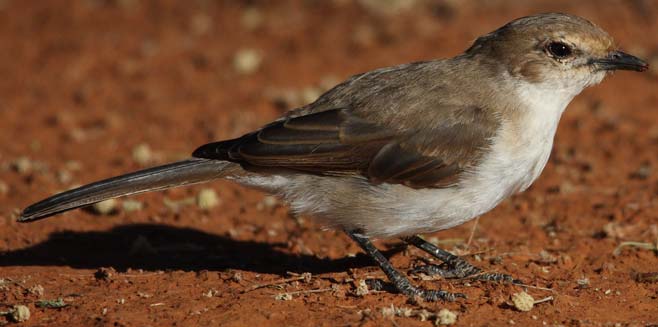 |
| Marico flycatcher, Mokala National
Park, South Africa. [photo
Duncan Robertson ©]. |
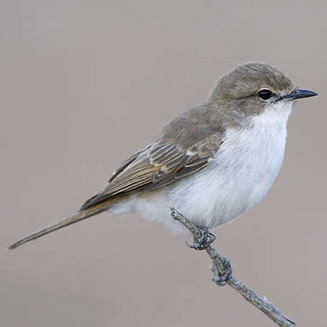 |
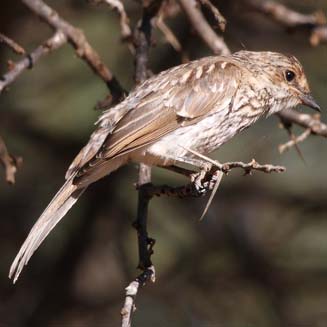 |
| Marico flycatcher, Kgalagadi National
Park, South Africa. [photo
Johann Grobbelaar
©] |
Marico flycatcher juvenile, Mokala
National Park, South Africa. [photo
Duncan Robertson ©]. |
Distribution and habitat
Near-endemic to southern Africa, occurring from southern
Angola and Zambia to Namibia, Botswana, northern South Africa and southern
Mozambique. It generally prefers arid Acacia savanna, but it also
occupies mixed and Mopane (Colosphermum mopane) woodland, but only if
these include Acacia trees. In winter it is more common in open habitats,
such as open woodland and fallow fields, but in summer it often moves into
taller, more shady habitats.
|
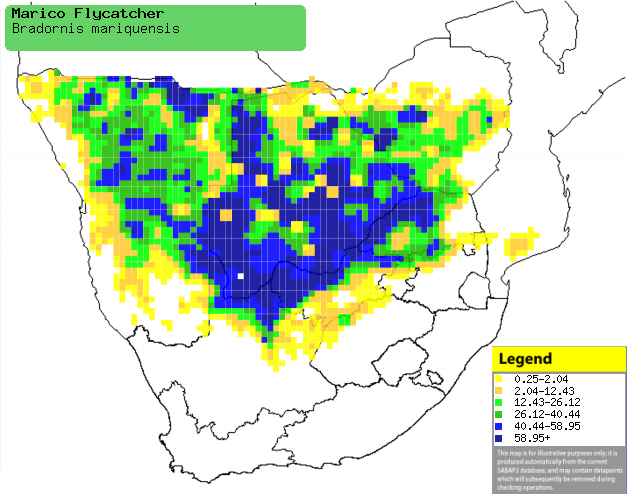 |
|
Distribution of Marico flycatcher in southern Africa,
based on statistical smoothing of the records from first SA Bird Atlas
Project (©
Animal Demography unit, University of
Cape Town; smoothing by Birgit Erni and Francesca Little). Colours range
from dark blue (most common) through to yellow (least common).
See here for the latest distribution
from the SABAP2. |
Brood parasites
It has been recorded as host of the
Diderick
cuckoo.
Food
It mainly eats insects, doing most of its foraging from an
exposed perch such as a fencepost or outermost tree branch, from which it
pounces on prey on the ground. It also gleans food from the tree canopy, and it
may even hawk insects aerially, although this is rarely recorded. The following food items have been recorded
in its diet:
- Insects
- Fruit
- Rhus pyroides (Common currant)
- Euclea undulata (Guarri)
Breeding
- Monogamous, sometimes facultative cooperative breeder, meaning that the
breeding pair can be assisted by other adults.
- The nest (see image below) is a small, flimsy cup built of dry grass and
weed stems and lined with rootlets and feathers. The floor of the nest is
often so thin that that the eggs can be seen from below. It is typically
placed between forked twigs in the outermost branches of a thorny tree,
usually very difficult to spot, even if the tree doesn't have any leaves.
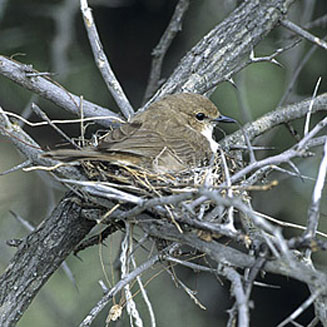 |
|
|
Marico flycatcher at its nest, Sericea
farm, South Africa. [photo Warwick Tarboton ©] |
|
- Egg-laying season is year-round, peaking around October-November in most
areas, although in Namibia it peaks later, in March.
- It lays 2-3, rarely 4 eggs, which are probably incubated solely by the
female, who is fed by the male and sometimes other group members.
- The chicks are intermittently brooded and fed by both parents and
sometimes helpers, leaving the nest after about 14 days. They still remain
and forage with their parents for about 7 weeks, at which point they become
fully independent.
Threats
Not threatened.
References
-
Hockey PAR, Dean WRJ and Ryan PG 2005. Roberts
- Birds of southern Africa, VIIth ed. The Trustees of the John Voelcker
Bird Book Fund, Cape Town.
|
